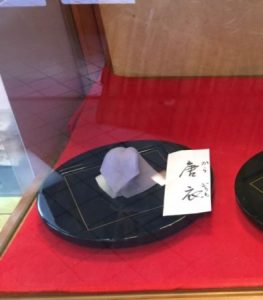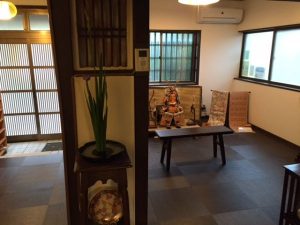It’s difficult to say who is the most beautiful! ~ Iris in May in Japan~
Aoi festival was held in May 15th the day before yesterday, so the best season for iris passed, but still we can see beautiful purple flowers in O-ta shrine, the sub-shrine of Kamigamo shrine. It is assigned as the Natural Monument in Japan because of the iris which has been seen since Heian period (794-1192) in Kyoto.
Talking about iris, there are some kinds of iris on May in Japan “shobu” (Acorus calamus), “Ayame” (Iris sanguinea) and “kakitsubata”(Iris laevigata).
Kakitsubata (Iris laevigata)
Iris laevigata has been described in the short poems since over 1000 years ago in Japan. Not only poems but also I often find them painted on the big folding screen or campus in the museum.
Although it’s not Kyoto, but Tokyo, I love Nezu Museum which garden is full of iris laevigata in May. Even in the rain, they were so beautiful. I saw the famous National Treasure, “Kakitsubata zu byo-bu”(iris laevigata on the folding screen) painted by Ko-rin Ogata (1658-1716) then, which seems being often displayed around May every year.
In Kyoto, O-ta shrine is the most famous for the iris laevigata and mayby the second one is the garden of Heian shrine. I have been to Heian shrine many times to see the beautiful iris in the pond.
The Japanese sweets of Iris “Karakoromo”
Some sweets shops have already finished making Karakoromo this year because it’s already middle in May.
But I’d like to write about Karakoromo since it is really beautiful Japanese sweets designed from iris laevigata.
Why “Karakoromo” instead of Kakitsubata? I guess it’s because of the short poem written by Ariwarno Narihira (825-880).
Seeing the iris in Aichi prefecture, he said, “I feel I’ve gone far away from Kyoto, seeing the tired clothes I wear”. Actually, it’s rhyming for the different meanings that “I miss my wife in Kyoto.”
Karakoromo is the old Japanese word we don’t use so often now. Maybe it is used only in the old poem. Hearing this old name, we Japanese remember the poem of Ariwarano Narihira. So, it’s more romantic to name “Karakoromo” for the sweets than just “iris”.
Hanashobu (Acorus calamus) and Ma-shobu (True iris)
The acorus calamus is displayed in the photo. In Japanese we use a metaphor for iris when it’s difficult to choose one or difficult to say who is the most beautiful. It goes back to Minamotono Yorimasa (1106-1180) made a short poem “ I can’t say which is Ayame (Iris sanguinea) or Kakitsubata (iris laevigata)” when he is trying to receive the most beautiful lady from 12 women.
On the other hand, Ma-shobu doesn’t have any beautiful flowers, but just a small brown fruit. The way to arrange is very special because both the plants living in the water and on the land are put together. It’s only the way for May 5th in Misho-ryu Japanese flower arrangement.
In this photo, wormwoods are put with. It’s the rule that a small brown fruit parts the world of 2 kinds of plants. The contrast of deep green and pale green is beautiful.
In this way, we have some interesting way of decollating iris in Japan.
Even it’s already in the middle of May, we can still enjoy iris in Kyoto.









